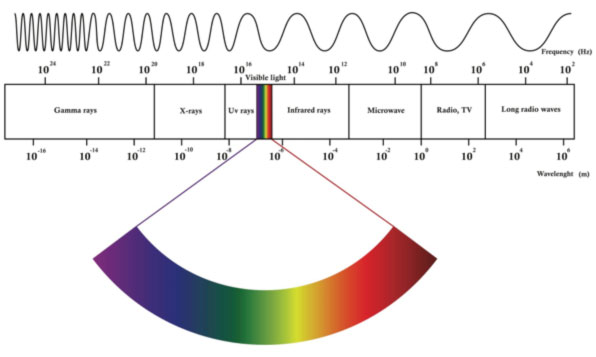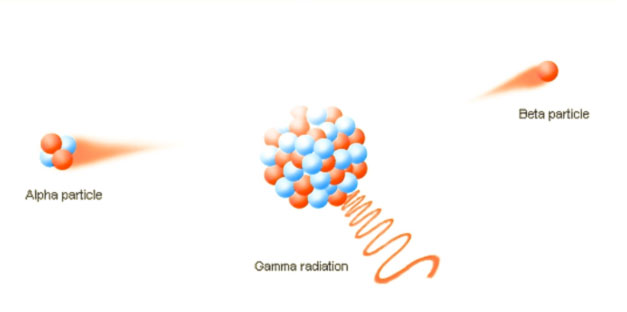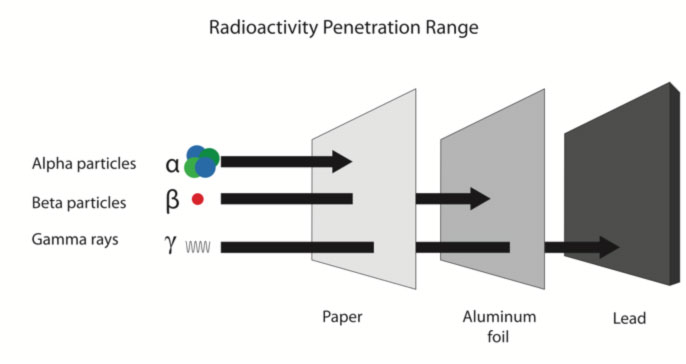How to Reduce Radiation Risk
Common sense and some basic information can greatly reduce radiation exposure and risk for most people. Here is some basic information to help you minimize your dose and risk.
Things to be Aware of:
- Humans cannot sense ionizing radiation. When we have been in the sun too long our body usually tells us itʻs time to get in the shade. Ionizing radiation is different. We cannot see, hear or sense ionizing radiation under normal circumstances, unless we have radiation detector to help us out.
- All radiation isnʻt the same. Sunlight and light from the stars (and the lights in your home) are electromagnetic radiation. So is the radiation from your microwave oven. This article is focused on radiation that ionizes. Although there are risks from exposure to sunlight and microwave radiation, that risk is from a different type of impact than the risk created by ionizing radiation.
- Ionizing Radiation comes in Waves. One form of ionizing radiation (gamma radiation) is
 electromagnetic (much like the visible light from the stars), but itʻs wavelength is shorter and thus more penetrating. It has enough energy to alter atoms, molecules and DNA. It can also create free radicals in the human body.
electromagnetic (much like the visible light from the stars), but itʻs wavelength is shorter and thus more penetrating. It has enough energy to alter atoms, molecules and DNA. It can also create free radicals in the human body. - Gamma Radiation and X Rays Share Similar Characteristics. Both are electromagnetic with wavelengths shorter (and more penetrating) than visible light. Gamma rays are released when unstable radioactive minerals release energy as they change state and chemical composition. X-rays are created by humans (usually deliberately) in an electrical mechanical process, typically for the purpose of medical or industrial imaging. Some energies of gamma and x radiation are more potentially damaging than others, but that is a big discussion. As a general rule, itʻs good to limit exposure to gamma and x rays, and other forms of ionizing radiation, to as low as reasonably achievable.
- Ionizing Radiation also comes in the form of charged particles. There are subatomic particles that can ionize matter when released from an atom undergoing transition – and the most notable of these are alpha and beta particles. An alpha particle has a positive charge,
 and beta particles are negatively charged. This drawing is overly simplified just to show the basic concept . An alpha particle actually consists of two large positively charged particles from the nucleus of an atom (protons), coupled to 2 neutrons (no electrical charge). Beta particles are what we call the orbital electrons (negatively charged) when they are released by an atom undergoing change.
and beta particles are negatively charged. This drawing is overly simplified just to show the basic concept . An alpha particle actually consists of two large positively charged particles from the nucleus of an atom (protons), coupled to 2 neutrons (no electrical charge). Beta particles are what we call the orbital electrons (negatively charged) when they are released by an atom undergoing change. - Waves and Particles both Matter. There is a lot going on in the invisible subatomic realm. While gamma and x rays are basically light that has such short wavelength that it is outside the visible range, particles have mass and weight. Both forms of ionizing radiation can affect matter by altering other atoms, molecules and DNA (what we are made of).

- More about Particles. New particles are still being discovered. For radiation protection purposes the focus is mainly on Alpha and Beta particles. Alpha particles, each containing 2 protons and 2 neutrons from the nucleus of an atom undergoing transition, have a large mass that goes along with that positive electrical charge. They are considered to be potentially 20 times more biologically damaging than gamma and beta radiation if the source is inhaled or ingested. Alpha particles, on the other hand, arenʻt much of a health risk outside the body. They cannot penetrate our skin or even a sheet of paper. Beta particles are much smaller than alpha particles, and have a negative electrical charge. They are essentially electrons that usually orbit the nucleus of an atom, but are sometimes released in the process of radioactive decay. Low energy beta radiation cannot penetrate matter easily. On the other hand, some beta radiation is quite penetrating. Thatʻs also a big discussion. As a general rule limiting exposure to alpha and beta radiation is an important safety practice.
- More about Alpha radiation: Although not nearly as penetrating as beta and gamma radiation, alpha radiation can actually be more damaging if the source is taken internally by respiration or ingestion.

- More about Beta Radiation. Beta radiation is often ignored in dosimetry. Risk from beta radiation is relative depending on the energy of the particle and whether the source is external or ingested. Certain radionuclides that emit beta radiation, such as Strontium 90, can accumulate in the bones and create increased health risk.
- We Should not forget Neutrons. (especially if you work around nuclear reactors). They donʻt have an electrical charge like alpha and beta particles, but they do have mass and can induce biological effects. If you donʻt work around reactors or strategic nuclear materials there is little or no reason to be concerned about them. If you do work around an operating reactor then you need special training and specialized instruments to protect yourself. If you are trying to detect certain materials used in nuclear weapons, neutrons detection can be important.
How to Protect Yourself
- If you work around radioactive materials itʻs good to have a radiation detector. Things change from day to day. Other workers can forget to replace shielding around sources. X-ray machines can be be inadvertently activated. Things can get spilled. Itʻs good to review your environment on a regular basis.
- Counting on a Dosimeter can leave you Vulnerable. Dosimeters generally tell you what dose you have received after the fact. While this may be useful for regulatory compliance and limiting your lifetime dose, it does not help you keep your dose minimized on a day to day basis.
- Use Time Distance and Shielding to Protect Yourself. Putting distance and shielding between you and a radiation source is an immediately effective way of reducing your exposure. Reducing the time you are being exposed is another way.

(Image Courtesy of US EPA) - Use a Respirator or Face Mask if You are exposed to airborne sources.
- Properly Label Sources and keep them Shielded.
- Be Aware of All Sources of Radiation Exposure. We are all exposed to radiation every day from natural sources, outer space, the earth, radon gas in our homes and businesses. We are also exposed inadvertently to sources that can include people undergoing medical procedures, radioactive antiques such as Fiestaware, and diagnostic medical procedures. The book Living With Radiation – The First 100 Years by Paul Frame and William Kolb, document some radioactive items that still can be found in homes, flea markets and antique stores.
- Be Thoughtful and Informed about Medical X-rays. Medical imaging can provide important and life saving diagnostic information. It is also sometimes used unnecessarily. Sometimes the same diagnostic information can be obtained by using techniques that reduce dose. If you have concerns about the dose and benefits you may receive from a proposed procedure, take time to inform your self and also have a conversation with your health care professional with any concerns you might have. If you continue to have reservations or concerns, you can always ask for a second opinion. Here is a link to the FDA Initiative to Unnecessary Radiation Exposure from Medical Imaging
Things to Think About
Risk Reduction is usually an automatic process for most potential hazards. It s something that we do every day, whether we are conscious about it or not. When we pull our car out from a side street onto a main road our eyes, ears and brain are at heightened awareness. We are sensing, observing, listening, internally calculating the speed of oncoming vehicles, making judgements about when it is safe to proceed and how rapidly or slowly to do so. With radiation we are limited in what we can see, so we need instruments, knowledge and awareness to navigate.
Knowledge and Instrumentation can form the basis for awareness in the invisible world of ionizing radiation. A good radiation detector will help you learn what is hot and what is not. Many people will find that things are pretty normal around them. Every person with a good instrument will also find that we are surrounded by naturally occurring radiation all of the time. Whether it is the muons raining on the surface of the earth from outer space, or the naturally occurring radiation in the soil beneath our feet, there is always some radiation present in our lives. We canʻt do anything about that. What we want to do is limit the extra and unnecessary exposures that are preventable, and relax. Stress can also cause health problems.
______________________________________________
References on Radiation Safety
National Academies of Science
BEIR VII Report http://dels.nas.edu/resources/static-assets/materials-based-on-reports/reports-in-brief/beir_vii_final.pdf
United States Environmental Protection Agency
• Radiation Protection Basics http://www.epa.gov/radiation/understand/protection_basics.html
• Ionizing and Non-Ionizing Radiation http://www.epa.gov/radiation/understand/index.html
• Health Effects http://www.epa.gov/radiation/understand/health_effects.html
Other Sources of Information:
National Council on Radiation Protection http://www.ncrponline.org
